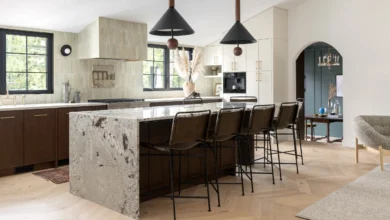8-inch or 10-inch frying pan? Which one to Choose

When you are looking for a new frying pan, you will have to decide what size is the right size for you. The frying pans come in sizes 6, 8, 10, 12 and 14 inches.The most popular sizes are the 8-inch and the 10-inch frying pan.
If you are cooking for one or two people, then an 8-inch or 10-inch frying pan is probably the right size for you. But you are cooking for a family, then a 12 to 14-inch frying pan is probably the right size for you.
Now there are multiple sizes of pans available in the market to choose from. If you are considering getting a new cooking pan, select the correct size.
8 Inch Frying Pan
An 8-inch frying pan is somehow tiny as compared to other similar items of 10 inches. It mainly cooks food for one person, including one egg, a piece of chicken breast, or steak. It usually has a total of 8-8.5 inches in diameter with 5 inches cooking surface available. Usually, it has a 2.5-3 inches height and 15 inches total length.
Advantage
Cooking a small 8” pizza, one pancake, and one serving of anything is like a breeze with this pan size. Most of the 8 inches pans from top-notched brands are lighter than 10 inches pans, thus making tossing food a great option.
Disadvantage
The main disadvantage of this size is that if you have one friend at your home, you have to make food in turns rather than having two servings together. It takes extra time; if you have, go for it; otherwise, select a big one.
10 inches pan
Ten inches frying pan is best suited for a medium to large family. It enables cooking 2-3 eggs, two chicken breasts, and sautéing vegetables. With a 10.5 inches diameter, 7 inches cooking surface, 3-4 inches height, and 18-19 inches height, this frying pan will be best for a family of 2-3 persons. The weight and dimensions vary from brand to brand.
Advantage
This pan size is best for baking bread or pies and making food for your friend coming to meet you. It is closest to the standard size used in different recipes, so one does not have to convert recipe ingredients measurements.
Disadvantage
A 10-inch frying pan will often need more space for storage and on cooktops. It will also provide leftovers if you are making food for one person.
What to choose- 8 inches or 10 inches pan?
Overcrowding is the most critical before purchasing perfect-sized cookware so it can be avoided to the maximum level. Cooking for one person in a hostel or a patient at home is different, while cooking for a family of two to three is another.
What pan size you should use for cooking mainly depends on the number of people waiting for dinner. If you live alone, you should select an 8 inches fan; however, a 10-inch pan will work for a family of two to three.
Undoubtedly, a smaller pan retains more heat and distributes it evenly through the food. Generally, one should go for a 10 inches pan to avoid overcrowding and mixing food well. A 10 inches cookware allows cooking perfectly with just a little heat loss than in an 8 inches pan.
Factors to consider before finding a right size pan
Stovetop size and storage space
Some small kitchens have a small stovetop which means it occupies cookware of small size on burners. If you use more than one pan on narrow stovetops, an 8-inch pan is often a better option than a 10-inch one. The same is the case with storage space; if you have adequate space for storage, go for the large option.
Maneuverability, weight, and material
The heavier 10-inch pans are less maneuverable than small 8-inch pans. The weight is another consideration that depends on the material also. A pan of cast iron is heavier than others of the same size, but with a different material, so it is easier to manage a small-sized pan than a large-sized pan. A 10-inch pan is ideal for a family of three but is heavier than 8-inch pans.
Heat retention and conduction
Thanks to the smaller 8-inch pan, it will get heated faster and evenly than the 8-inch pan of the same brand and material. There are no risks of hot spots in a smaller pan. Heat retention is mainly a material-oriented feature but also relies on size. A 10-inch pan will retain more heat than an 8-inch pan.
What is the most valuable- size or material of a pan?
A person finding two main cookware features under solo flight is the luckiest. These two most important features of a pan are the material of the pan and for how many people it can allow cooking. Typically, ladies focus on the material first and can easily adjust the size if unable to find the size of their choice. In recent years, nonstick, cast iron, stainless steel, and carbon steel frying pans have been in high demand, available in 8,10 and 12 inches sizes.
Conclusion
Selecting a pan of the right size might not look like a significant consideration, but it is. Different pans are available, so you must buy the right size after considering various factors. However, it is essential to consider that size best suits your family members or the things you will cook in it.
FAQs
How many sizes of frying pans are available in the market?
The pans are available in different sizes, from the smallest frying pan of 8 inches for one individual to the largest of 17-18 inches. The rest sizes include 10 inches, 12 inches, and 15 inches frying pans.
How to measure a frying pan’s size?
The pans in the market have a number on the sticker placed on the handle where sizes and other features are mentioned. Also, one can measure frying pan size using a measuring tape from the outside edge to the other, moving it from the middle of the pan.
Which pan size is best for one person?
If you want a frying pan for one person, select an 8-inch pan to have one serving of food while cooking. There will be no leftovers after eating food.
Are 10 inches pans too small?
A 10 inches pan is neither too small nor too big; instead, it is perfect for two-three persons. It is best for sautéing vegetables, roasting an eight-ounce steak and making molests for two persons.




